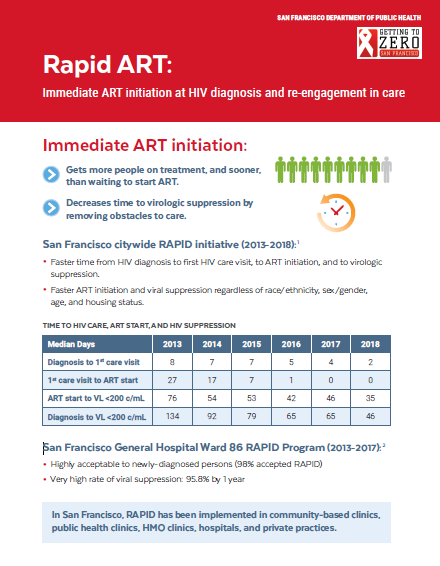San Francisco at CROI 2018 – Poster Presentations
The End of AIDS
February 22, 2018
San Francisco at CROI 2018 – Oral Abstracts
March 8, 2018Several abstracts were accepted for either poster or oral presentation at the Conference on Retroviruses and Opportunistic Infections (CROI) conference held in Boston this week. The following were presented for poster presentation.
Abstract Number: 908
DEGREE OF HOUSING INSTABILITY SHOWS INDEPENDENT “DOSE-RESPONSE” WITH HIV SUPPRESSION
Poster: http://www.croiconference.org/sites/default/files/posters-2018/1430_ClemenziAllen_908.pdf
Abstract: http://www.croiconference.org/sessions/degree-housing-instability-shows-independent-%E2%80%9Cdose-response%E2%80%9D-hiv-suppression
Angelo A. Clemenzi-Allen, Elvin Geng, Katerina A. Christopoulos, Hali Hammer, Susan P. Buchbinder, Diane V. Havlir, Monica Gandhi
Summary: Housing instability is associated with worse clinical outcomes among people living with HIV (PLHIV), but housing status is often dichotomized to homeless vs not without a nuanced evaluation of the continuum of unstable housing. We evaluated the association of multiple levels of housing status and virologic suppression (VS) among PLHIV in a large clinic-based cohort. We demonstrate strong associations between dwelling type and VS among PLHIV across a continuum of unstable housing arrangements. Although living outdoors is associated with the lowest proportion of VS, other forms of instability (including living in a shelter, ‘couch-surfing’, and being in an SRO) are also associated with lower levels of VS compared to being housed. Interventions are needed to increase VS among PLHIV across a spectrum of unstable housing arrangements.
Abstract Number: 1015
DISPARITIES IN PrEP UPTAKE AMONG PRIMARY CARE PATIENTS SCREENED FOR HIV/STIS IN SF
Poster: http://www.croiconference.org/sites/default/files/posters-2018/1430_Scott_1015.pdf
Abstract: http://www.croiconference.org/sessions/disparities-prep-uptake-among-primary-care-patients-screened-hivstis-sf
Hyman Scott, Anne Hirozawa, Miranda Nordell, Monica Gandhi, Catherine James, Hali Hammer, Susan Scheer, Susan P. Buchbinder
Summary: Although pre-exposure prophylaxis (PrEP) across San Francisco is expanding, significant age, gender, and racial/ethnic disparities in uptake persist. Using a registry of patients receiving PrEP, or at high risk but not on PrEP in the San Francisco Department of Public Health Primary Care (SFPC) clinics, Hyman Scott and colleagues evaluated disparities in PrEP uptake. Patients were defined as “high risk” if they received rectal STD screening; or had a history of syphilis, or 3 or more HIV tests within a 2 year period – suggesting their providers assessed them at ongoing risk for HIV. Overall, 451 patients were confirmed to have started PrEP and 2,109 patients were identified as high-risk non-PrEP patients. In adjusted analysis, women, patients 50 years or older, and Black and Latino patients were most likely to not have received PrEP. These data suggest additional interventions are needed both to ensure PrEP is offered to high-risk patients and barriers for PrEP use are removed in order to address PrEP uptake disparities.
Abstract Number: 1100
IMPROVEMENT IN HIV CARE INDICATORS AMONG THE HOMELESS IN SAN FRANCISCO
Poster: http://www.croiconference.org/sites/default/files/posters-2018/1430_Scheer_1100.pdf
Abstract: http://www.croiconference.org/sessions/improvement-hiv-care-indicators-among-homeless-san-francisco
Susan Scheer, Ling Hsu, Darpun Sachdev, Oliver Bacon, Stephanie Cohen, Albert Liu, Jennie Chin, Susan Buchbinder
Summary: Homeless persons with HIV are less likely than persons with stable housing to have experienced the recently observed improvements HIV-related care indicators in San Francisco.
The SF HIV surveillance registry was used to measure HIV-related care indicators among PLWH by housing status. Compared to all persons diagnosed in 2006-2016, homeless persons were significantly more likely to be cis women (14% vs 7%), trans women (10% vs 3%), African American (27% vs 14%) or a person who injects drugs (58% vs 20%) (all p<.001). Among newly diagnosed persons in 2015, retention and viral suppression were significantly lower among the homeless compared to the housed and, among all persons living with HIV, homeless persons were less likely to be linked to care, retained in care and virally suppressed (p<.05). Among homeless PLWH who completed the LINCS short-term intensive case management program, 90% were re-linked to care within 3 months and 77% were virally suppressed within 12 months. Additionally, between 2013-2016, the median days from diagnosis to viral suppression deceased significantly among the homeless (median days 133 in 2013 to 57 days in 2016, p<.0001).
City-wide rapid linkage to care and intensive case management programs are beginning to show progress in decreasing disparities among homeless PLWH.
Abstract Number: 1028
FACTORS IMPACTING APPROPRIATE HIV/STI SCREENING AND PrEP PERSISTENCE IN PRIMARY CARE
Poster: http://www.croiconference.org/sites/default/files/posters-2018/1430_Spinelli_1028.pdf
Abstract: http://www.croiconference.org/sessions/factors-impacting-appropriate-hivsti-screening-and-prep-persistence-primary-care
Matthew A. Spinelli, Hyman Scott, Eric VIttinghoff, Albert Y. Liu, Alicia Morehead-Gee, Rafael Gonzalez, Monica Gandhi, Susan P. Buchbinder
Summary: As PrEP expands, sufficient monitoring is needed, and a focus on persistence is needed to ensure disparities on PrEP are not worsened. We found that providers only perform HIV and sexually-transmitted infection screening in approximately 2/3 of follow-up intervals, and that patients persist on PrEP for a median of only 6 months in a diverse primary care population. There was an association with shorter PrEP persistence when comparing African-Americans compared to Whites and transgender women having sex with men compared to men having sex with men. Case management and mobile health technologies should be studied for their impact on PrEP persistence and PrEP disparities.
Abstract Number: 463
PHARMACOLOGIC MEASURES OF PrEP ADHERENCE AMONG HIGH-RISK MSM IN HPTN 067
Poster: http://www.croiconference.org/sites/default/files/posters-2018/1430_Velloza_463.pdf
Abstract: http://www.croiconference.org/sessions/pharmacologic-measures-prep-adherence-among-high-risk-msm-hptn-067
Jennifer Velloza, Monica Gandhi, Craig W. Hendrix, Peter Bacchetti, Pamela Murnane, James P. Hughes, Maoji Li, Marcel Curlin, Timothy H. Holtz, Sharon Mannheimer, Mark A. Marzinke, K. Rivet Amico, Estelle Piwowar-Manning, Susan H. Eshleman, Robert M. Grant


